Country
Crash of a Learjet 35A off Fort Lauderdale: 4 killed
Date & Time:
Nov 19, 2013 at 1956 LT
Registration:
XA-USD
Survivors:
No
Schedule:
Fort Lauderdale - Cozumel
MSN:
35A-255
YOM:
1979
Crew on board:
2
Crew fatalities:
Pax on board:
2
Pax fatalities:
Other fatalities:
Total fatalities:
4
Captain / Total hours on type:
1400.00
Copilot / Total hours on type:
175
Aircraft flight hours:
6842
Circumstances:
During takeoff to the east over the ocean, after the twin-engine jet climbed straight ahead to about 2,200 ft and 200 knots groundspeed, the copilot requested radar vectors back to the departure airport due to an "engine failure." The controller assigned an altitude and heading, and the copilot replied, "not possible," and requested a 180-degree turn back to the airport, which the controller acknowledged and approved. However, the airplane continued a gradual left turn to the north as it slowed and descended. The copilot subsequently declared a "mayday" and again requested vectors back to the departure airport. During the next 3 minutes, the copilot requested, received, and acknowledged multiple instructions from the controller to turn left to the southwest to return to the airport. However, the airplane continued its slow left turn and descent to the north. The airplane slowed to 140 knots and descended to 900 ft as it flew northbound, parallel to the shoreline, and away from the airport. Eventually, the airplane tracked in the direction of the airport, but it continued to descend and impacted the ocean about 1 mile offshore. According to conversations recorded on the airplane's cockpit voice recorder (CVR), no checklists were called for, offered, or used by either flight crewmember during normal operations (before or during engine start, taxi, and takeoff) or following the announced in-flight emergency. After the "engine failure" was declared to the air traffic controller, the pilot asked the copilot for unspecified "help" because he did not "know what's going on," and he could not identify the emergency or direct the copilot in any way with regard to managing or responding to the emergency. At no time did the copilot identify or verify a specific emergency or malfunction, and he did not provide any guidance or assistance to the pilot. Examination of the recovered wreckage revealed damage to the left engine's thrust reverser components, including separation of the lower blocker door, and the stretched filament of the left engine's thrust reverser "UNLOCK" status light, which indicated that the light bulb was illuminated at the time of the airplane's impact. Such evidence demonstrated that the left engine's thrust reverser became unlocked and deployed (at least partially and possibly fully) in flight. Impact damage precluded testing for electrical, pneumatic, and mechanical continuity of the thrust reverser system, and the reason the left thrust reverser deployed in flight could not be determined. No previous instances of the inflight deployment of a thrust reverser on this make and model airplane have been documented. The airplane's flight manual supplement for the thrust reverser system contained emergency procedures for responding to the inadvertent deployment of a thrust reverser during takeoff. For a deployment occurring above V1 (takeoff safety speed), the procedure included maintaining control of the airplane, placing the thrust reverser rocker switch in the "EMER STOW" position, performing an engine shutdown, and then performing a single-engine landing. Based on the wreckage evidence and data recovered from the left engine's digital electronic engine control (DEEC), the thrust reverser rocker switch was not placed in the "EMER STOW" position, and the left engine was not shut down. The DEEC data showed a reduction in N1 about 100 seconds after takeoff followed by a rise in N1 about 35 seconds later. The data were consistent with the thrust reverser deploying in flight (resulting in the reduction in N1) followed by the inflight separation of the lower blocker door (resulting in the rise in N1 as some direct exhaust flow was restored). Further, the DEEC data revealed full engine power application throughout the flight. Although neither flight crewmember recognized that the problem was an inflight deployment of the left thrust reverser, certification flight test data indicated that the airplane would have been controllable as it was configured on the accident flight. If the crew had applied the "engine failure" emergency procedure (the perceived problem that the copilot reported to the air traffic controller), the airplane would have been more easily controlled and could have been successfully landed. The airplane required two fully-qualified flight crewmembers; however, the copilot was not qualified to act as second-in-command on the airplane, and he provided no meaningful assistance to the pilot in handling the emergency. Further, although the pilot's records indicated considerable experience in similar model airplanes, the pilot's performance during the flight was highly deficient. Based on the CVR transcript, the pilot did not adhere to industry best practices involving the execution of checklists during normal operations, was unprepared to identify and handle the emergency, did not refer to the appropriate procedures checklists to properly configure and control the airplane once a problem was detected, and did not direct the copilot to the appropriate checklists.
Probable cause:
The pilot's failure to maintain control of the airplane following an inflight deployment of the left engine thrust reverser. Contributing to the accident was the flight crew's failure to perform the appropriate emergency procedures, the copilot's lack of qualification and capability to act as a required flight crewmember for the flight, and the inflight deployment of the left engine thrust reverser for reasons that could not be determined through postaccident investigation.
Final Report:
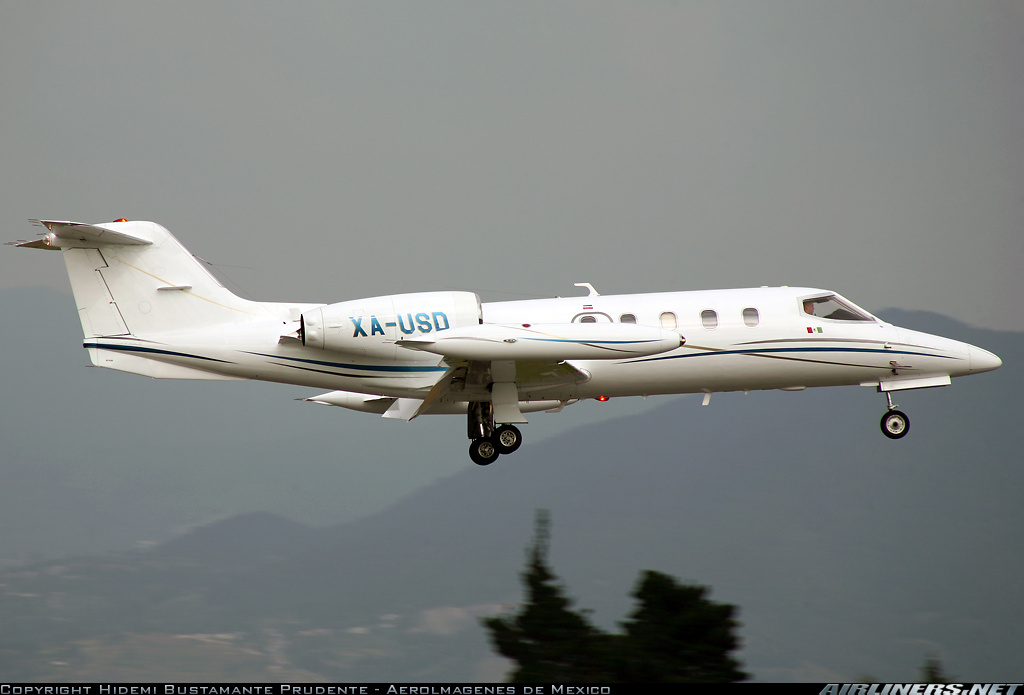


Crash of a Learjet 35A in McMinville
Date & Time:
May 13, 2013 at 1245 LT
Registration:
N22MS
Survivors:
Yes
Schedule:
Grand Junction - McMinville
MSN:
209
YOM:
1978
Crew on board:
2
Crew fatalities:
Pax on board:
1
Pax fatalities:
Other fatalities:
Total fatalities:
0
Captain / Total hours on type:
996.00
Copilot / Total hours on type:
94
Aircraft flight hours:
15047
Circumstances:
The crew of the twinjet reported that the positioning flight after maintenance was uneventful. However, during the landing roll at their home base, the thrust reversers, steering, and braking systems did not respond. As the airplane approached the end of the runway, the pilot activated the emergency braking system; however, the airplane overran the end of the runway, coming to rest in a ditch. None of the three occupants were injured, but the airplane sustained substantial damage to both wings and the fuselage. Two squat switches provided redundancy within the airplane’s electrical system and were configured to prevent inadvertent activation of the thrust reversers and nosewheel steering during flight and to prevent the airplane from landing with the brakes already applied. Because postaccident examination revealed that the squat switch assemblies on the left and right landing gear struts were partially detached from their mounting pads such that both switches were deactivated, all of these systems were inoperative as the airplane landed. The switch assemblies were undamaged, and did not show evidence of being detached for a long period of time. The brakes and steering were working during taxi before departure, but this was most likely because either one or both of the switches were making partial contact at that time. Therefore, it was most likely that the squat switch assemblies were manipulated on purpose during maintenance in an effort to set the airplane’s systems to “air mode.” Examination of the maintenance records did not reveal any recent procedures that required setting the airplane to air mode, and all mechanics involved in the maintenance denied disabling the switches. Mechanics did, however, miss two opportunities to identify the anomaly, both during the return-to-service check and the predelivery aircraft and equipment status check. The anomaly was also missed by the airplane operator’s mechanic and flight crew who performed the preflight inspection. The airplane’s emergency braking system was independent of the squat switches and appeared to operate normally during a postaccident test. Prior to testing, it was noted that the emergency brake gauge indicated a full charge; therefore, although evidence suggests that the emergency brake handle was used, it was not activated with enough force by the pilot. The pilot later conceded this fact and further stated that he should have used the emergency braking system earlier during the landing roll. The airplane was equipped with a cockpit voice recorder (CVR), which captured the entire accident sequence. Analysis revealed that the airplane took just over 60 seconds to reach the runway end following touchdown, and, during that time, two attempts were made by the pilot to activate the thrust reversers. The pilot stated that as the airplane approached the runway end, the copilot made a third attempt to activate the thrust reversers, which increased the engine thrust, and thereby caused the airplane to accelerate. Audio captured on the CVR corroborated this statement.
Probable cause:
Failure of maintenance personnel to reattach the landing gear squat switches following maintenance, which rendered the airplane's steering, braking, and thrust reverser systems inoperative during landing. Contributing to the accident were the failure of both the maintenance facility mechanics and the airplane operator's mechanic and flight crew to identify the error during postmaintenance checks, a failure of the airplane's pilot to apply the emergency brakes in a timely manner, and the copilot's decision to attempt to engage the thrust reversers as the airplane approached the runway end despite multiple indications that they were inoperative and producing partial forward, rather than reverse, thrust.
Final Report:
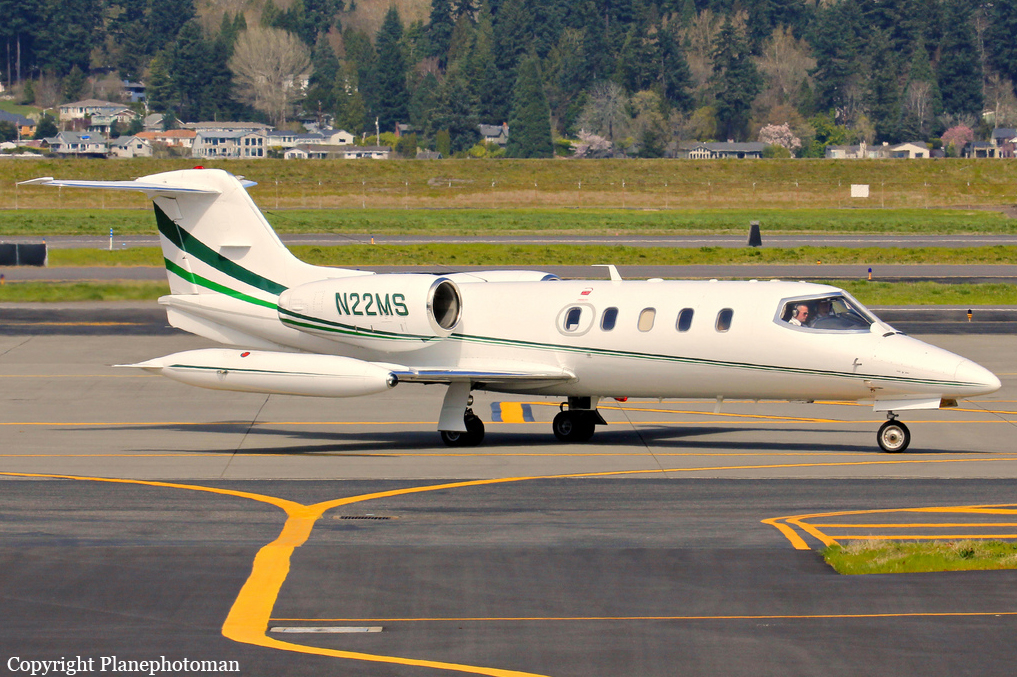


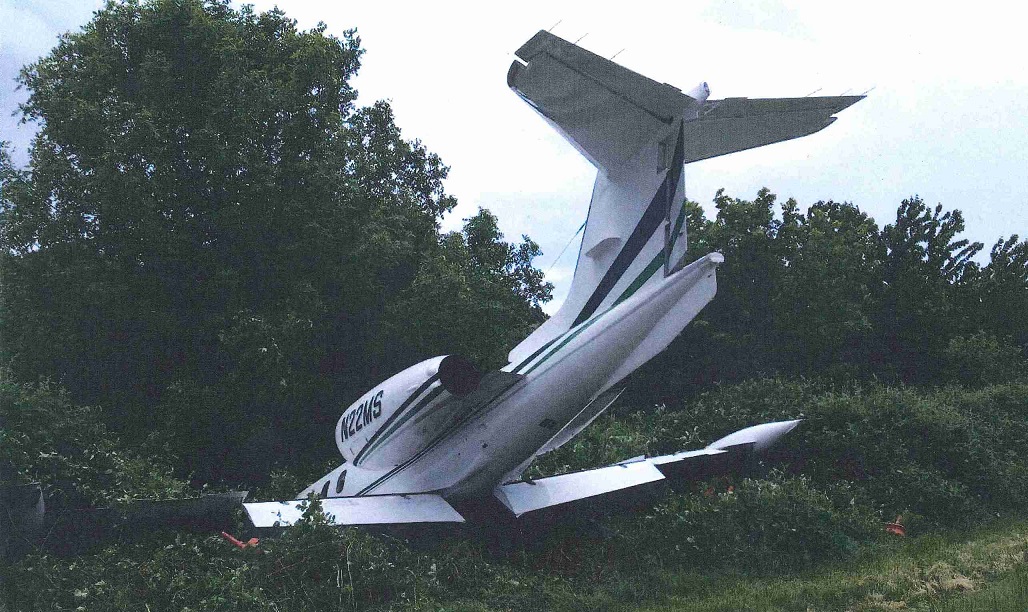
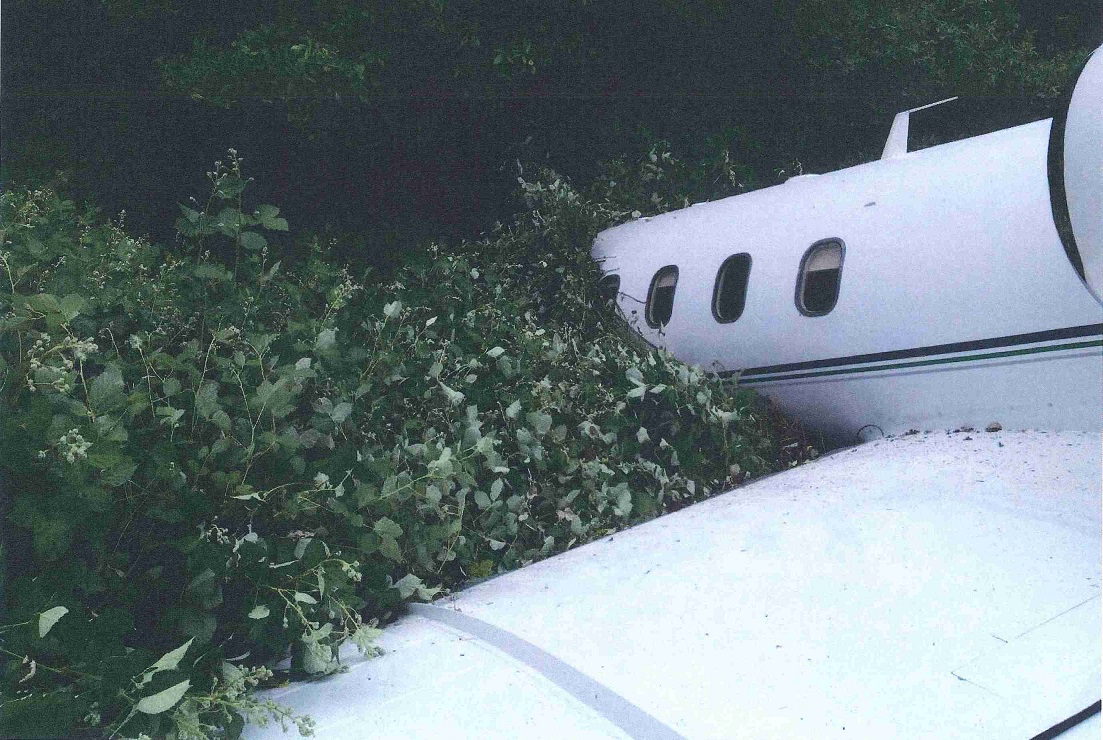
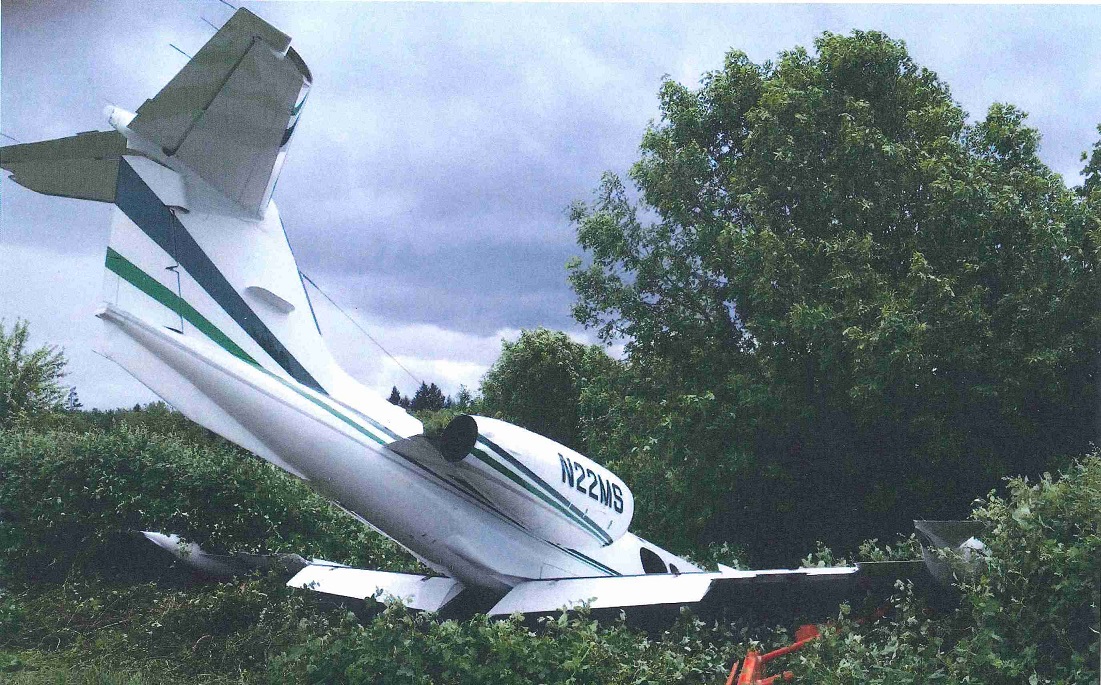
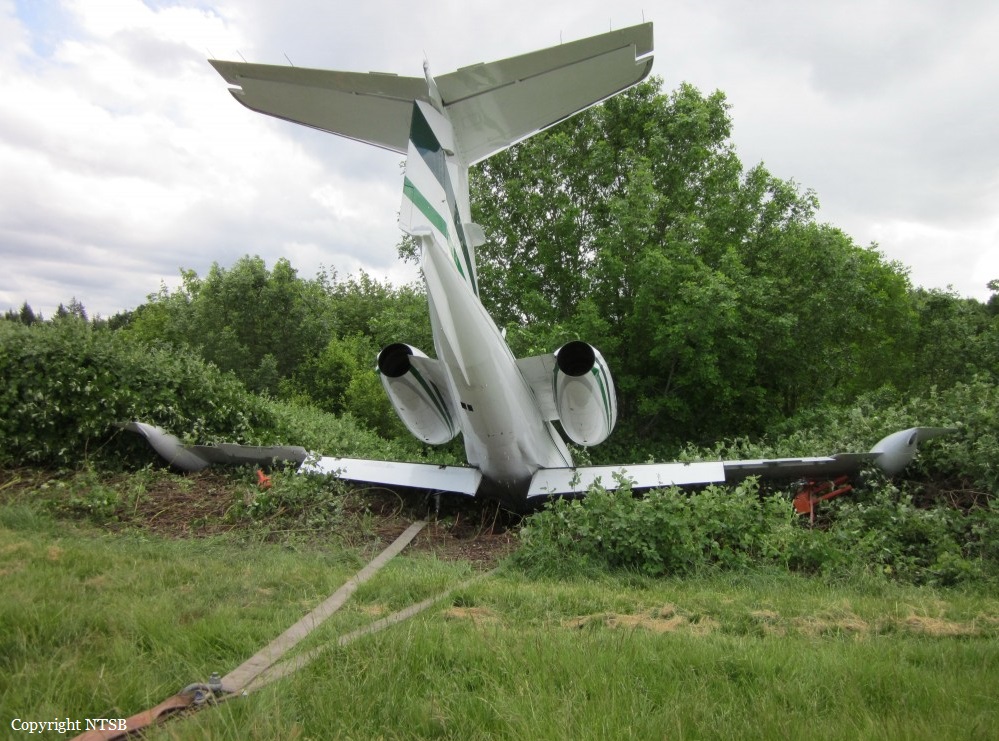
Crash of a Learjet 35A in Springfield
Date & Time:
Jan 6, 2011 at 1100 LT
Registration:
N800GP
Survivors:
Yes
Schedule:
Chicago - Springfield
MSN:
35A-158
YOM:
1978
Flight number:
PWA800
Crew on board:
2
Crew fatalities:
Pax on board:
4
Pax fatalities:
Other fatalities:
Total fatalities:
0
Captain / Total hours on type:
827.00
Aircraft flight hours:
16506
Circumstances:
The flight encountered light rime icing during an instrument approach to the destination airport. The copilot was the pilot flying at the time of the accident. He reported that the airframe anti-icing system was turned off upon intercepting the instrument approach glide slope, which was shortly before the airplane descended below the cloud layer. He recalled observing light frost on the outboard wing and tip tank during the approach. The stick shaker activated on short final, and the airplane impacted left of the runway centerline before it ultimately departed the right side of the runway pavement and crossed a slight rise before coming to rest in the grass. The cockpit voice recorder transcript indicated that the pilots were operating in icing conditions without the wing anti- ice system activated for about 4 1/2 minutes prior to activation of the stick shaker. A postaccident examination of the airplane did not reveal any anomalies consistent with a preimpact failure of the flight control system or a loss of anti-ice system functionality. A performance study determined that the airplane’s airspeed during the final 30 seconds of the flight was about 114 knots and that the angle of attack ultimately met the stick shaker threshold. The expected stall speed for the airplane was about 93 knots. The airplane flight manual stated that anti-ice systems should be turned on prior to operation in icing conditions during normal operations. The manual warned that even small accumulations of ice on the wing leading edge can cause an aerodynamic stall prior to activation of the stick shaker and/or stick pusher.
Probable cause:
The pilot’s decision to conduct an instrument approach in icing conditions without the anti-ice system activated, contrary to the airplane flight manual guidance, which resulted in an inadvertent aerodynamic stall due to an in-flight accumulation of airframe icing.
Final Report:
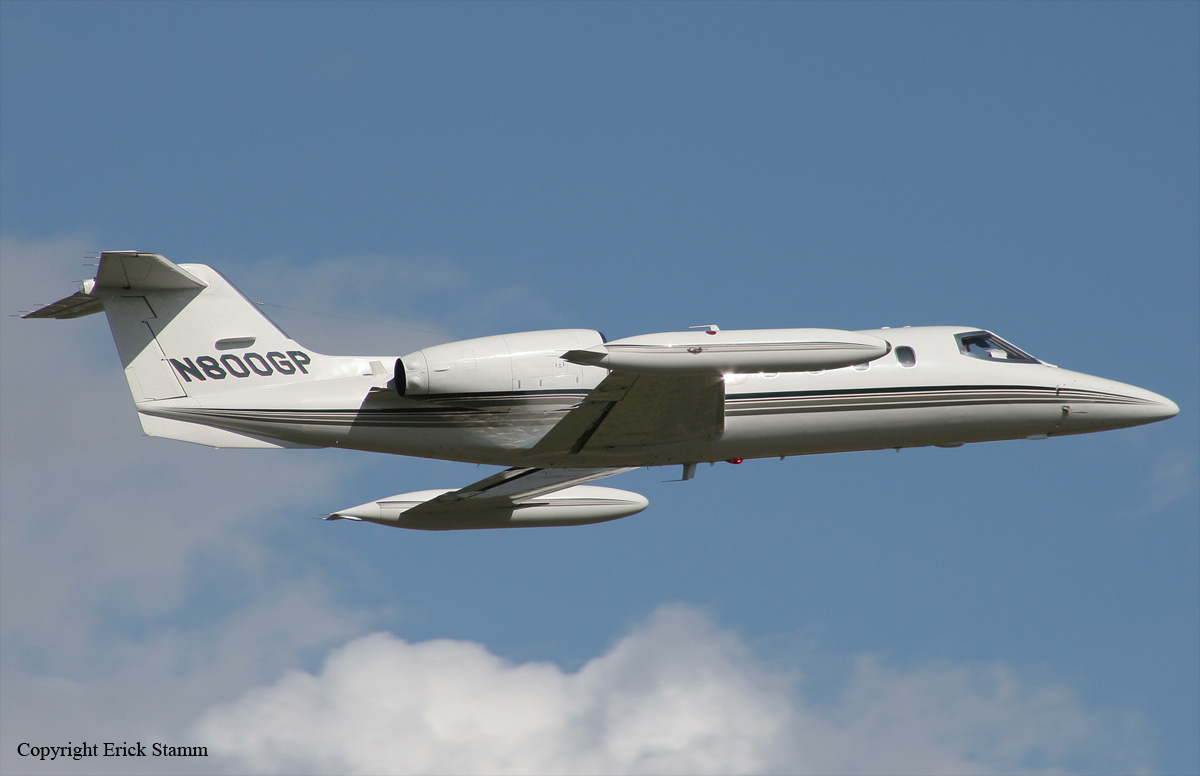
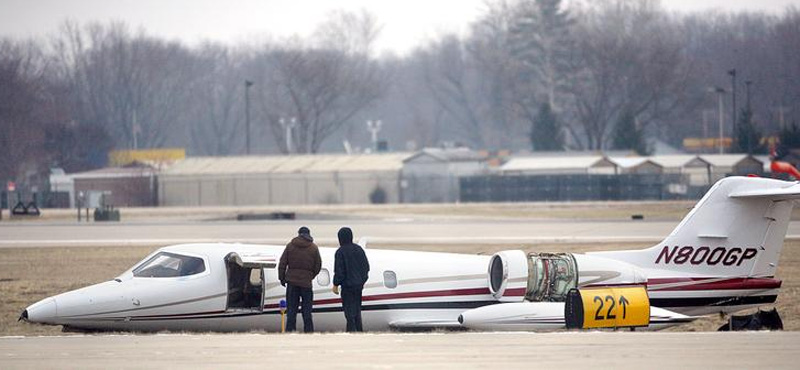
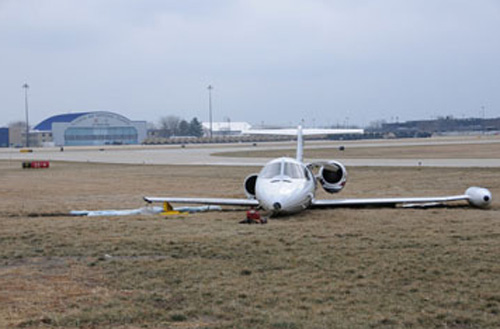

Crash of a Learjet 35A in Jeffersonville
Date & Time:
Mar 21, 2010
Registration:
N376HA
Survivors:
Yes
Schedule:
Lexington – Jeffersonville
MSN:
35-477
YOM:
1982
Crew on board:
0
Crew fatalities:
Pax on board:
0
Pax fatalities:
Other fatalities:
Total fatalities:
0
Circumstances:
For unknown reasons, the aircraft landed hard at Jeffersonville-Clark County Airport. There were no injuries among the people on board and the aircraft was damaged beyond repair due to severe damages to the left wing and the tail section.
Probable cause:
No investigation conducted by the NTSB.

Crash of a Learjet 35A in Manaus
Date & Time:
Mar 7, 2010 at 1535 LT
Registration:
PT-LJK
Survivors:
Yes
Schedule:
Palm Beach – Aguadilla – Manaus – Rio de Janeiro
MSN:
35-372
YOM:
1981
Crew on board:
2
Crew fatalities:
Pax on board:
4
Pax fatalities:
Other fatalities:
Total fatalities:
0
Captain / Total hours on type:
754.00
Copilot / Total hours on type:
410
Circumstances:
The aircraft was completing an ambulance flight from Palm Beach to Rio de Janeiro with intermediate stops in Aguadilla and Manaus, carrying one patient, a medical team and two pilots. During the takeoff roll from 10 at Manaus-Eduardo Gomes Airport, just before V1 speed, the crew heard a loud noise coming from the right side of the airplane. In the mean time, the aircraft started to deviate to the right. The captain decided to abandon the takeoff procedure and initiated a braking maneuver. Unable to stop within the remaining distance, the aircraft overran and came to rest 400 metres past the runway end. All six occupants escaped uninjured while the aircraft was damage beyond repair.
Probable cause:
The following findings were identified:
- The external tyre on the right main gear deflated during the takeoff roll,
- The crew retarded the power levers and deployed the spoilers,
- The crew did not use the parachute, judging the relative low speed and thinking this was an optional equipment,
- Technical analysis on the right main gear revealed that the six bolts on the external wheel torque were approximately 90% lower than foreseen, which may contributed to the tyre deflection.
- The external tyre on the right main gear deflated during the takeoff roll,
- The crew retarded the power levers and deployed the spoilers,
- The crew did not use the parachute, judging the relative low speed and thinking this was an optional equipment,
- Technical analysis on the right main gear revealed that the six bolts on the external wheel torque were approximately 90% lower than foreseen, which may contributed to the tyre deflection.
Final Report:




